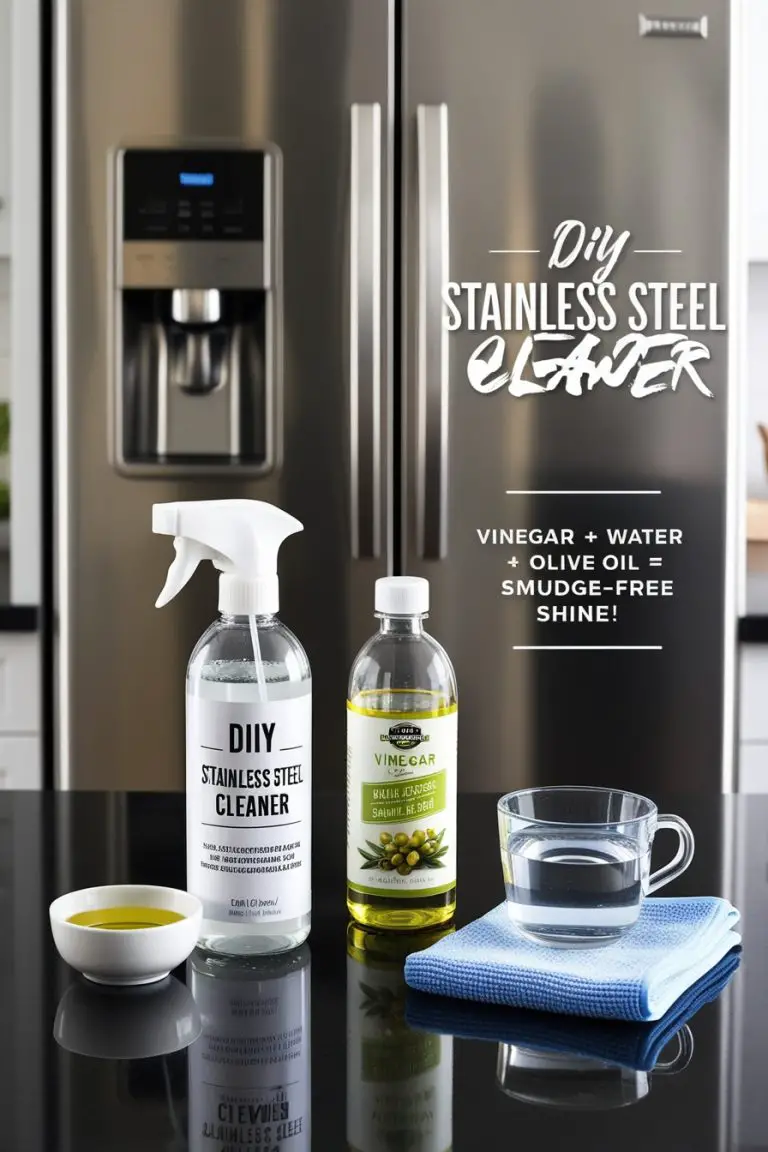Hey there! 👋
So, let’s be real for a second—cleaning the oven is probably one of the least fun kitchen chores. I used to dread it. I mean, baked-on grease, food splatters that have been sitting there for way too long—it’s like a nightmare in there sometimes.
And don’t even get me started on the strong, chemical-laden cleaners out there that practically burn your nose hairs the moment you open the bottle.
That’s why I decided to ditch the harsh stuff and go the natural route. I’ve been making my own natural oven cleaner for a while now, and it’s a total game-changer!
Not only does it work wonders on stubborn grime, but I also feel so much better knowing that I’m not breathing in toxic fumes or coating my kitchen in chemicals.
Plus, it’s super easy to make with just a few ingredients you probably already have in your pantry. Let me show you how I do it!

Why Go Natural?
Before I share my recipe, I have to tell you why I’m so into using natural cleaners. First off, I love knowing that my cleaning products are safe for my family, pets, and the environment.
Conventional oven cleaners can be filled with some pretty scary stuff, and I didn’t want that hanging around where I cook my food. And honestly, using natural ingredients is surprisingly effective without the headache (literally) of chemical fumes.
Alright, enough chit-chat! Let’s get into the good stuff—here’s how I make my natural oven cleaner.
My Super Simple Natural Oven Cleaner Recipe
You’re going to love how easy this is! It’s all about using basic, natural ingredients that are gentle but powerful enough to cut through the grime. Here’s what I use:
What You’ll Need:
- 1/2 cup baking soda (the scrubbing hero)
- 1/4 cup white vinegar (for that satisfying fizz and degreasing power)
- A few drops of liquid dish soap (optional, but helps break down grease)
- A few drops of essential oils (optional, but I love using lemon or tea tree for a fresh scent)
- Water (to form a paste)
- A sponge or cloth
- A spray bottle (for the vinegar)
How I Make It:
- Mix up the baking soda paste
First things first, I make a paste with the baking soda and water. I usually start with about 1/2 cup of baking soda in a bowl and add just enough water to create a thick paste—kind of like toothpaste. If you want, you can also add a squirt of dish soap to help cut through the grease, but it’s totally optional. I also like to throw in a few drops of essential oil (lemon or tea tree are my faves) just to give it a fresh scent while I’m scrubbing.
- Spread the paste all over the oven
Next, I use a sponge or a cloth to spread the baking soda paste all over the inside of the oven—on the bottom, sides, and even the door. I make sure to get into all the nooks and crannies where grime tends to hide. The baking soda is great because it’s abrasive enough to scrub away the tough stuff but gentle enough that it won’t scratch the surface of the oven.
- Let it sit
This is the hard part… waiting! I let the paste sit for at least a few hours, but honestly, overnight is even better. The longer you let it sit, the more it breaks down those stubborn baked-on spots. If you’re short on time, a few hours will do, but I usually just leave it overnight and come back to it in the morning.
- Spritz with vinegar and scrub
After letting the baking soda do its thing, I come back and spray the whole oven down with white vinegar. As soon as the vinegar hits the baking soda, it’ll start fizzing up—that’s when you know it’s working! The fizzing helps lift off the grime and makes scrubbing so much easier. I take my sponge or cloth and scrub away at the spots, focusing on any areas that look extra greasy or dirty.
- Wipe it all clean
Once I’ve scrubbed the oven, I wipe it all down with a damp cloth or sponge to remove the baking soda, vinegar, and any loosened grime. You might need to rinse your cloth a few times to get all the paste off, but the results are totally worth it. Your oven will be looking so much better, and you didn’t have to use a single harsh chemical!
Why This Works (and Why I Love It!)
This natural oven cleaner works wonders for me because baking soda is an amazing natural abrasive, and vinegar is a powerful degreaser.
Together, they team up to cut through all that greasy, baked-on mess without you having to break a sweat.
The dish soap is optional, but it’s great for dissolving grease, and the essential oils add a fresh, clean scent without being overpowering.
Plus, I love that this cleaner is totally non-toxic. I don’t have to worry about it being safe around food or pets, and there’s no lingering chemical smell in my kitchen afterward. Just fresh, clean air and a sparkling oven!
A Few Tips I’ve Learned Along the Way:
- Tough spots? Make a baking soda and vinegar paste! If you have really stubborn spots that won’t budge, I make a thicker paste with baking soda and a little vinegar. Let it sit for another 10-15 minutes, and then give it a good scrub. Works like a charm!
- Don’t forget the oven racks! I take my oven racks out and soak them in hot, soapy water for a bit while I clean the inside of the oven. Then I scrub them with a sponge to get rid of any stuck-on grime. You can also sprinkle them with baking soda and spray them with vinegar for extra cleaning power.
- Regular maintenance makes it easier! Now that I’m using natural cleaners, I try to wipe down the inside of the oven more regularly to avoid letting grime build up. It makes the deep cleaning days a lot less daunting!
Give It a Try!
If you’ve been avoiding cleaning your oven because you don’t want to deal with harsh chemicals or hours of scrubbing, this natural oven cleaner is going to change the game for you. It’s simple, affordable, and works like a charm without any toxic fumes or headaches.
Let me know if you try it out! I’d love to hear how it works for you, and if you’ve got any tips of your own for keeping your oven clean, send them my way. Happy cleaning! 😊✨
Discover:

Emma Vanderlyn is a home enthusiast with a passion for all things natural and eco-friendly. With years of experience experimenting with DIY solutions, she’s dedicated to creating safe, effective, and budget-friendly cleaning recipes that are kind to both your home and the planet. Emma believes that a clean home shouldn’t come at the cost of harsh chemicals, and her easy-to-follow guides make natural cleaning accessible to everyone.
When she’s not whipping up a new cleaner in her kitchen, Emma can be found researching the latest in green living or transforming her space with mindful, stylish decor ideas. She’s here to share her love of natural living and help you create a home that shines—naturally.




